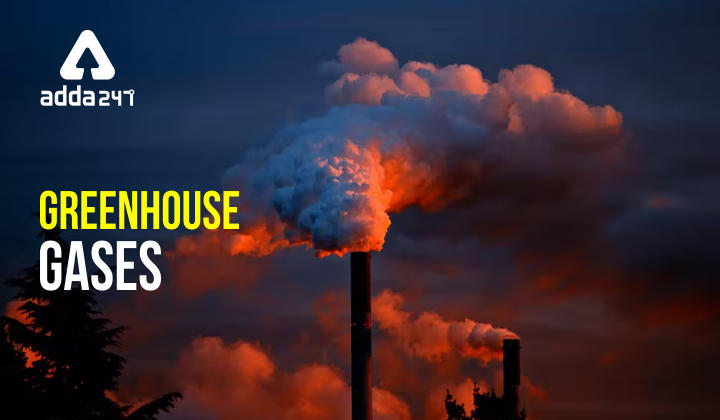What are Greenhouse Gases?
Greenhouse gases or GHG or GhG, are the gases that under the thermal infrared range, absorb and emit radiant energy causing the greenhouse effect. The greenhouse gases consist of various gases which include Carbon dioxide, methane, water vapor, and ozone. The greenhouse gases maintain the temperature of the earth which is 15°C, if the greenhouse gases are not present on earth, the temperature of the earth will be -18°C. Not only earth, but planets like Venus, and Mars also have greenhouse gases.
Today, carbon dioxide is increased up to 50% in the atmosphere due to human activities. The industrial revolution in the world has caused an increase in carbon dioxide from 280 ppm to 419 at present. A massive amount of carbon dioxide is produced due to the combustion of fossil fuels like coal, petroleum, and natural gas, manufacturing of cement, fertilizer, and deforestation.
Buy Prime Test Series for all Banking, SSC, Insurance & other exams
Greenhouse gases: Major constituents
The main constituents of Earth’s atmosphere such as Nitrogen, oxygen, and Argon are not a part of greenhouse gases. These molecules contain two atoms of the same elements like N2 and O2, which do not let the electrical charge distribute when these molecules vibrate and argon is a monatomic gas that doesn’t vibrate. These gases are not affected by infrared radiation and hence, these are not greenhouse gases. If we consider some molecules which have two atoms of different elements and absorb infrared radiation like Carbon monoxide and hydrogen chloride, these molecules are short-lived in the atmosphere, hence, these gases are also not considered greenhouse gases.
Greenhouse gases are those that absorb and emit infrared radiation. The accepted greenhouse gases are carbon dioxide, nitrogen oxide, methane, and ozone. The most abundantly found greenhouse gases in the atmosphere are as follows.
- Water Vapour
- Carbon dioxide
- Methane
- Nitrogen oxide
- Ozone
- Chlorofluorocarbons
- Hydrofluorocarbons
- Perfluorocarbons
Let’s look into these components in detail.
- Water Vapour is the gaseous form of water. They are formed by evaporation or boiling of water or by sublimation of ice. It is abundant in the atmosphere and acts as a greenhouse gas. Water Vapour contributes more than the other non-condensable gases such as carbon dioxide and methane.
- Carbon dioxide- It is the most important constituent of greenhouse gases. The carbon dioxide is emitted naturally through volcanoes, combustion, decay of organic matter, and respiration of aerobic organisms.
- Methane- It is the second most important constituent of greenhouse gases. The radiative forcing produced per molecule by methane is greater than carbon dioxide. However, methane is found in less concentration than carbon dioxide.
- Nitrogen and HFCs and PFCs- These gases are additional constituents of greenhouse gases. These are formed by industrial activities. Nitrogen is low in concentration because of the biological reaction in soil and water but HFCs and PFCs are abundant in industrial areas.
- Ozone- Here, we are talking about low-level ozone or surface-level ozone. It is a result of air pollution but naturally, it occurs as stratospheric ozone.
Removal of Greenhouse gases
- Through physical changes like condensation, and precipitation can be used to remove the water vapor from the atmosphere which is a huge constituent of greenhouse gases.
- Through chemical reactions in the atmosphere, methane can be eliminated from the atmosphere.
- Through physical exchange between the atmosphere and other components of earth.
- Through chemical changes between the atmosphere and other components of the earth. This can eliminate Carbon dioxide from the atmosphere.
- Through photochemical changes, this will eliminate HFCs and PFCs from the atmosphere.
- Through Technology, this can eliminate Carbon dioxide from the atmosphere with technologies like Carbon dioxide air capture or bio-energy with carbon capture and storage.
FAQs related to Greenhouse Gases
1. What is the greenhouse effect?
Ans. The energy coming from the sun is trapped, reflected, or transmitted by the earth’s atmosphere. Greenhouse gases trap these energies, which means these gages absorb infrared radiation and increase the temperature. This results in the greenhouse effect.
2. Name any two greenhouse gases?
Ans. Methane and carbon dioxide are two components of greenhouse gases.
3. Which greenhouse gases produce the maximum Greenhouse effect?
Ans. Water Vapour contributes to the maximum production of the greenhouse effect.
4. Is ozone a greenhouse gas?
Ans. Ozone is a component of greenhouse gas.



 Indian Olympic Medal Winners List Till N...
Indian Olympic Medal Winners List Till N...
 Who is the Inventor of the Gramophone?
Who is the Inventor of the Gramophone?
 HS Dhaliwal Appointed New DGP Of Andaman...
HS Dhaliwal Appointed New DGP Of Andaman...
